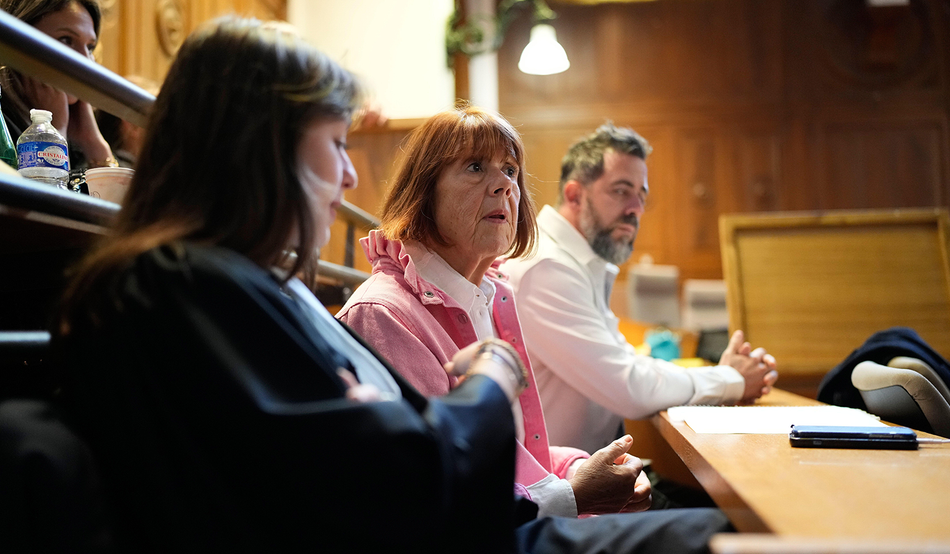“Victims are always humiliated in court.”
The words left Gisèle Pelicot’s lips with disarming calm, yet in the Nîmes courtroom they struck like a gavel—an indictment of French justice itself. Behind her, rows of women—journalists, activists and ordinary citizens—sat in quiet solidarity and shared understanding. Many of us had been there last autumn, in Avignon, when the 72-year-old first confronted the 50 men her husband Dominique had invited to rape her as she slept. Many of the reporters I spoke to told me that they, too, had been on the receiving end of such courtroom humiliation after reporting sexual abuse.
Almost a year after the landmark Pelicot trial shocked the world, the survivor who had dared to break anonymity, who had said that “shame must change sides”, was back in court—and forced to admit that it hadn’t. Once again she was forced to watch, to explain, to justify.
One man, Husamettin Dogan, 44, had appealed his conviction. Appeals are risky ventures. At best, they require new evidence, a repentance on the part of the perpetrator, or a coherent strategy. None of this was evident after four days of trial in the Nîmes court of appeal. If there was any semblance of a strategy, it was the oldest one in the book: denial and victim blaming. And unlike in the Avignon criminal court, with its professional magistrates, his defence in Nîmes would now have to convince a peer jury.
From the first day, Dogan’s lawyers requested to project footage of Gisèle Pelicot in lingerie or swimming nude, taken years before the crimes. The intent was crude but familiar—to sexualise the victim, to sow doubt, to suggest complicity.
Around me, journalists breathed defeated sighs. For those of us who had covered the first trial, the sense of déjà vu was oppressive. This was the same shame, recycled by procedure, yet again levied against the victim. None of it had changed sides or been left behind in Avignon.
But Pelicot’s lawyers pushed back. “I thought we were past such manoeuvres,” said Stéphane Babonneau, warning that showing such footage would cause secondary victimisation—the retraumatisation of a victim through judicial process. The presiding judge agreed. The videos were ruled irrelevant and withheld from court.
It was a small act of restraint, but in France, where the victim’s past is routinely used as a weapon in rape trials, to have a judge recognise humiliation itself as harm felt like a shift. Perhaps it was even the start of a precedent.
In December 2024, after months of hearings in Avignon, 51 men were found guilty of raping Gisèle Pelicot. The court heard how, between 2011 and 2020, her husband Dominique had drugged and filmed her while strangers he met online took turns assaulting her inert body. The evidence was staggering, meticulously catalogued by Dominique, showing hours upon hours of footage of Pelicot unconscious and snoring, dressed in underwear she’d never seen, raped by men she’d never met.
This week, her lawyers told the court that those recordings had saved her life—without them, her word alone might not have been enough. Pelicot, who waived her right to anonymity, insisted on a public trial, saying, “Shame must change sides.” For many, she became the face of a reckoning over consent and sexual abuse that the French justice system had long resisted.
When the verdicts came, most of the men accepted their sentences. Only Dogan went through with his appeal. His retrial, a condensed four-day version of the original ordeal, reopened every wound.
On the third day, jurors watched 13 long minutes of footage showing Dogan assaulting Pelicot’s unconscious body in her marital bed. The courtroom held its breath; some jurors turned away when Dominique pried his wife’s mouth open so Dogan could insert himself into it. Others covered their faces. One wiped away tears.
Pelicot stared at Dogan, whose back was turned to the press. Later, in her deposition, she expressed her disgust that he had never taken his eyes away from the screen once, and that he had even seemed to “revel” in the videos.
And yet, when questioned, Dogan remained defiant. “I have never raped that woman,” he said. When probed, he argued that Pelicot was not a victim of rape, but that he was—because the videos projected in court violated his privacy. He argued that Dominique had given him his wife’s consent, and that he had not known she was drugged.
Then Pelicot took the stand herself. “You said I looked dead,” she told him. “When I see a dead person, I leave the room—or call the fire department. But you stayed for two hours. Own up to what you did. Stop hiding behind cowardice.”
The defence then questioned her. They described her “movement” or the “tonicity” of her body to suggest she might not have been entirely unconscious. They asked whether she maybe had failed to notice clues that her husband was drugging her.
At that point, Pelicot turned away from the jurors and towards the defence. “You have deeply humiliated me,” she said. “I put myself in the place of all victims.”
If the Avignon trial was a moment of national catharsis, the Nîmes appeal was its cruel aftershock.
What unfolded was more than an appeal; it was a case study in the pathology of French justice, where secondary victimisation is not the exception but the rule. It begins in the police station, where reports are met with suspicion, and continues through medical examinations, invasive questioning and moralising courtrooms.
In French rape trials, survivors are treated as unreliable narrators of their own pain. Their credibility is dissected through irrelevant detail—their clothes, their marriages, their behaviour, their sexuality before and after the assault.
The refusal to allow Dogan’s lawyers to project those images may prove more than symbolic. It signals that judges are beginning to grasp what the European Court of Human Rights (ECHR) and the Istanbul Convention against violence against women have long argued, that justice must be trauma-informed. The Istanbul Convention in particular requires states to prohibit questioning on a victim’s sexual history, and to ensure court procedures “avoid secondary victimisation”. Questions or evidence which shame the victim, it rules, violate their fundamental rights.
France is party to the ECHR, and has ratified the Istanbul Convention. Yet, the ECHR has repeatedly condemned France for allowing discriminatory language in cases of sexual violence. Still, the gap between principle and practice remains vast.
That gap was glaring earlier this year when French actor Gérard Depardieu was accused of rape. The debate that followed was not about the women who came forward, but about whether he had been unfairly “cancelled”. Politicians, including ministers, lined up to defend him. The presumption of innocence, they intoned, must prevail.
But what about the presumption of truth for victims? In France, which prides itself on being the country of the rights of man, women are still required to translate suffering into administrative language before it is believed.
The Depardieu affair revealed the same reflex that underlies much of French jurisprudence on sexual violence: the weaponisation of disbelief. It is the same instinct that asks why victims didn’t scream, why they stayed, or why they waited to report.
The presiding judge’s refusal to show the defence’s images in the Pelicot retrial may appear minor, but it could become a cornerstone for legal reform. If future courts rule that such tactics amount to secondary victimisation, they will finally be aligning France’s practice with its European obligations.
In his concluding remarks Pelicot’s lawyer Antoine Camus voiced a hope, that, “in light of the path carved by Gisèle Pelicot, this peer jury would proclaim that the country of the rights of man must also become that of woman.”
The scale of Gisèle Pelicot’s ordeal forced France to confront a reality it had long denied. Even the most incontrovertible evidence can fail to spare a victim from scepticism. Her insistence on transparency—on public hearings, on speaking her name—has been an act of both courage and pedagogy. “I want to say to victims to never be ashamed of what was imposed on them, because they’re never responsible,” she added in her conclusion.
In his plea on the last day of the trial, public prosecutor Dominique Sié asked the peer jury to “move from rape culture to a culture of consent.”
The next day, the verdict was read: ten years in prison, one more than Dogan had gotten in Avignon. A small increase, yet symbolically large—a recognition that denial itself is a form of cruelty.












